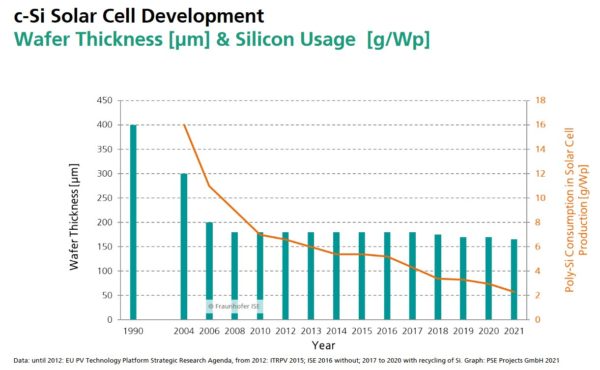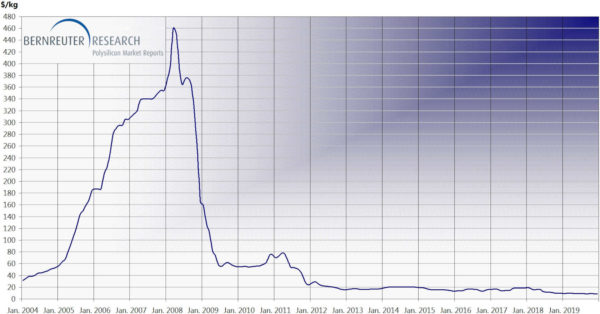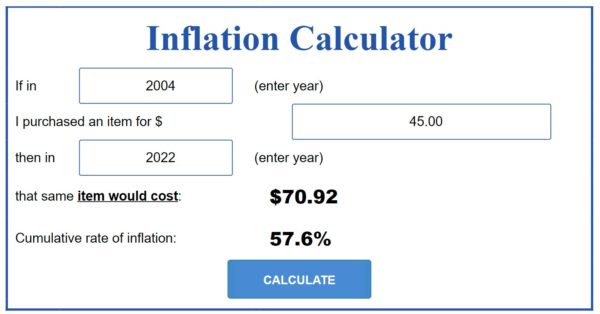Silicon is the semiconductor material at the heart of most solar cells. Thanks to advancements in technology, solar is now powering the world with a lot less silicon.
Research by Fraunhofer ISE shows that since 2004, the material usage of polysilicon per watt of solar cell has dropped by approximately 87%. The data suggests that in 2004, 16 grams of silicon were needed to produce a single watt of solar cell. By 2021, that number had shrunk to just over 2 grams.

For example, when the world’s largest solar farm – at just over 5 MW – turned on in Germany in 2004, it was using 150 watt solar panels. At the time, constructing one of these modules would have consumed 2,400 grams of the processed material.
In 2021, Maxeon signed a deal that 1.8 million of its Performance 5 UPP solar modules would be the powerhouse of the world’s 8th largest solar facility – the Primergy Solar farm in Nevada. If we assume that this 545 watt panel uses 2.2 grams of silicon per watt, we get 1,199 grams per module.
That’s approximately 360% higher output per solar panel — using only half of the silicon!
Of course, we’re going to use massively more silicon in 2023 than we did in 2004. In 2004, we deployed 1,044 MW of solar power, using just over 16,000 t of silicon globally. According to Bloomberg, 268 GW of solar was deployed in 2022, which is over 250 times more capacity than what was deployed in 2004. At 2.2 grams per watt, the 268 GW used approximately 590,000 ktg of silicon, or 35 times more silicon than was used in 2004.
The volume of silicon used is only half the story.
During the 2004 to 2022 window, the price of polysilicon actually did not stray too far from its original price, if we ignore inflation, and a few “bumps” along the way.

Source: Bernreuter Research
Bernreuter Research’s excellent history on those bumps in polysilicon pricing shows that in 2004, the price of the material was roughly $45 per kilogram. Between the end of 2003 and the end of 2004, the price of silicon nearly doubled, due to an expansion of German solar programs. But the price movement didn’t stop there. As the world’s installed solar capacity grew over 600% between 2004 and 2008, the price of polysilicon grew by about 1000%.
The price increases led to bankruptcies and lawsuits.
What followed was another dramatic price movement, as the manufacturing might of the Chinese government took the industry by storm. The growing nation determined that solar energy would be a national security consideration, and as a result, polysilicon prices plunged. Over the next two decades, we saw the price below $10/kg – with spot market moments in the $6/kg range. $6/kg is only 1.3% of polysilicon’s 2008 peak price of $460/kg.
In the past two years, we’ve seen the price of polysilicon increase to nearly $45/kg on heavy demand. And in the last month or two, we have seen pricing falling 54%, to $17, as a potential 536 GW of manufacturing capacity comes online.
The last variable to complete our analysis is inflation.

Source: Inflation Calculator
When accounting for inflation of the U.S. dollar, the $45/kg cost in 2004 is equal to about $71/kg in 2022. If we consider that it took 16 grams to make a single watt in 2004, then the inflation-adjusted cost per watt of polysilicon in 2004 was approximately $1.14/watt. In 2022, at 2.2 grams per watt at $17/kg – the price is $0.04/watt.
So, the real cost per watt of silicon has come down by 96.7%.
This article was ameded tno change the unit from kg to t in the following: In 2004, we deployed 1,044 MW of solar power, using just over 16,000 t of silicon globally. At 2.2 grams per watt, the 268 GW used approximately 590,000 t of silicon, or 35 times more silicon than was used in 2004.
This content is protected by copyright and may not be reused. If you want to cooperate with us and would like to reuse some of our content, please contact: editors@pv-magazine.com.







“In 2004, we deployed 1,044 MW of solar power, using just over 16,000 kg of silicon globally. According to Bloomberg, 268 GW of solar was deployed in 2022, which is over 250 times more capacity than what was deployed in 2004. At 2.2 grams per watt, the 268 GW used approximately 590,000 kg of silicon, or 35 times more silicon than was used in 2004.”
I believe these figures should be 16,000 metric tons and 590,000 metric tons rather than kilograms.